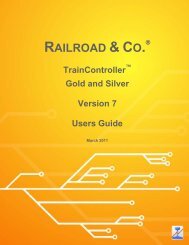Download - Freiwald Software
Download - Freiwald Software
Download - Freiwald Software
You also want an ePaper? Increase the reach of your titles
YUMPU automatically turns print PDFs into web optimized ePapers that Google loves.
!<br />
section B from the left, it will be decelerated to threshold speed within 50 inches from<br />
the left border of B. When it arrives at the point C, which is 50 inches away from the<br />
entrance to B, the train will be automatically stopped.<br />
In other words: the combined brake/stop indicator B with ramp 50 inches works exactly<br />
like a combination of a brake indicator with a braking ramp of 50 inches plus a stop<br />
contact located 50 inches behind this brake indicator.<br />
Combined brake/stop indicators allow operation of a complete block with one single<br />
indicator symbol.<br />
5.9 Block Signals<br />
General<br />
Traffic Blocking is used on real railroads to prevent two trains from running into each<br />
other by dividing the track into sections protected by signals. These signals (here called<br />
block signals) indicate to an oncoming train whether it can enter the block which begins<br />
beyond the signal. If the block ahead is occupied the driver of a train approaching the<br />
signal protecting that block sees a red stop light. If the section in front is unoccupied<br />
and the train has permission to enter it the driver sees a green signal light. In addition to<br />
the signal for the next block the driver is usually also presented with an advance signal<br />
which indicates the status of the block beyond that which is being entered. The advance<br />
signal indicates green, meaning that the following block is free to be entered; otherwise<br />
the block ahead is occupied and the train should proceed into the next block with caution<br />
and be prepared to stop at a red light.<br />
When a train is running under control of the Dispatcher, TrainController automatically<br />
calculates signal aspects taking into account the availability of blocks and routes<br />
in front of the train. These signal aspects are displayed in the block diagrams and as<br />
home and advance signal in the Train Window (see chapter 3, “Train ”). The signals indicate,<br />
whether the corresponding block may be left and how the following block must<br />
be entered. The brake and stop indicators assigned to a block take care that a train is<br />
stopped accordingly at the appropriate location. Since TrainController assumes that<br />
the brake and stop indicators belonging to a block are located near the exit of the block,<br />
this is also assumed for the imaginary location of block signals.<br />
TrainController already displays the signal aspect currently valid for a certain<br />
block, when the first indicator assigned to this block is reached. It is possible to say:<br />
125










